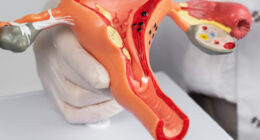Ovarian cysts are fluid-filled sacs or pockets in an ovary or on its surface. Many women will develop at least one cyst during their lifetime, often without knowing it. While most ovarian cysts are harmless and go away on their own, some can cause severe symptoms and complications. Understanding the symptoms, causes, and treatment options is crucial for managing this common condition.
Symptoms of Ovarian Cysts
Ovarian cysts often go unnoticed as they may not cause any symptoms. However, here are things to watch out for:
- Pelvic Pain: A dull or sharp ache in the lower abdomen on the side of the cyst.
- Fullness or Heaviness: A feeling of bloating or fullness in the abdomen.
- Irregular Menstrual Cycle: Changes in menstrual cycle timing, flow, or duration.
- Pain During Intercourse: Feeling of pain or discomfort during sexual activity.
- Frequent Urination: Pressure on the bladder causes urination to be more frequent.
- Difficulty Emptying the Bladder: A sensation of incomplete urination.
- Unexplained Weight Gain: Sudden and unexplained increase in weight.
- Nausea and Vomiting: Especially if the cyst causes the ovary to twist (ovarian torsion).

Causes of Ovarian Cysts
So many things can cause ovarian cysts, some of which are:
- Hormonal Imbalances: Conditions like Polycystic Ovary Syndrome (PCOS) can lead to multiple cysts.
- Endometriosis: Tissue similar to the lining inside the uterus can attach to the ovary, forming a cyst.
- Pregnancy: A cyst that forms during ovulation can sometimes remain on the ovary throughout pregnancy.
- Severe Pelvic Infections can spread to the ovaries and fallopian tubes, causing cysts.
- Previous Ovarian Cysts: Women with cysts are more likely to develop them again.
Types of Ovarian Cysts
- Functional Cysts are the most common and usually harmless, often disappearing on their own within a few menstrual cycles. Follicular cysts and corpus luteum cysts are some examples of functional cysts.
- Dermoid Cysts: Also known as teratomas, these can contain tissue like hair, skin, or teeth.
- Cystadenomas: These develop on the surface of an ovary and can be filled with a watery or mucous material.
- Endometriomas: These result from endometriosis and can cause significant pain and complications.
Diagnosing Ovarian Cysts
If an ovarian cyst is suspected, a healthcare provider may perform several diagnostic tests, including:
- Pelvic Exam: To feel for swelling or abnormalities in the ovaries.
- Ultrasound: To visualize the cyst and determine its size, location, and composition.
- Blood Tests: To check hormone levels and rule out pregnancy.
- Laparoscopy: A minimally invasive surgical procedure to view the ovaries directly and, if needed, remove the cyst.
Treatment Options for Ovarian Cysts
Cyst’s size, type, and symptoms determine the treatment. Options include:
- Watchful Waiting: Small, functional cysts often resolve on their own. Regular monitoring through ultrasounds may be recommended.
- Medications: To prevent the formation of new cysts, hormonal contraceptives are advised. Pain relievers can also be used to manage symptoms.
- Surgery: If a cyst is significant, persistent, or causes severe symptoms, surgical removal may be necessary. Options include laparoscopic surgery or, in more severe cases, laparotomy.
- Lifestyle Modifications: Maintaining a healthy weight, managing stress, and following a balanced diet can support ovarian health.
Conclusion
Ovarian cysts are a common condition that many women experience without significant issues. However, staying informed about the symptoms and treatment options is essential for those who may develop problematic cysts. Regular check-ups, awareness of body changes, and prompt consultation with healthcare providers can help manage ovarian cysts effectively and maintain overall reproductive health.
By understanding ovarian cysts, women can proactively manage their health and seek appropriate treatment. If you suspect you have an ovarian cyst, consult with a healthcare professional for personalized advice and care.









